Black Orchid Betta fish are a stunning addition to any aquarium. With their dark black bodies and vibrant orchid-like fins, they are sure to catch the eye of anyone who sees them. These fish are a popular choice among Betta enthusiasts due to their unique appearance and striking colors.
In this blog post, we will dive deeper into the world of Black Orchid Betta fish, exploring their origins, characteristics, and care requirements. Whether you are a seasoned Betta keeper or just starting out, this post will provide you with valuable insights into these fascinating fish. Join us as we explore the beauty and wonder of the Black Orchid Betta!
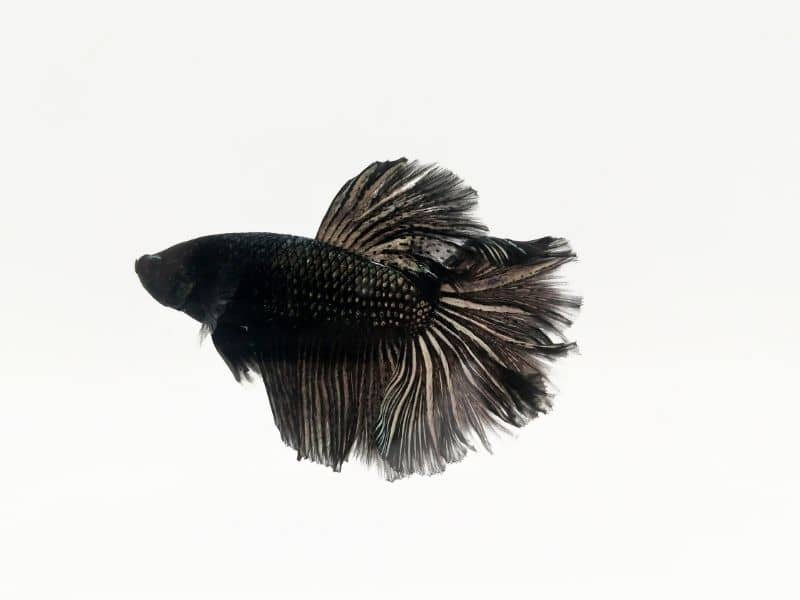
One look Care Guide
Jump To
- 1 One look Care Guide
- 2 What is a Black Orchid Betta?
- 3 Black orchid Betta as an aquarium pet
- 4 How Fast they Grow
- 5 How big they can grow?
- 6 the life expectancy of Black orchid Betta
- 7 Different types of orchid bettas
- 8 One look Care Guide
- 9 How to care for them
- 10 How do I keep my Black Orchid Betta healthy?
- 11 • How to maintain the tank?
- 12 Keeping Tips Summary
- 13 How much do Betta fish cost?
- 14 History and origin
- 15 Related questions
| Scientific name | B. splendens |
| Common names | Black Orchid Betta |
| Care Level | Easy |
| Native to | Thailand |
| Type | Air brooder fish |
| Color | Black |
| Life expectancy | 3-5 years |
| Tank size | Minimum 5 gallons |
| Preferred temperature | 70-82o F |
| pH | 6.5 – 7.5 |
| Other water parameters ammonia, Nitrate, Nitrite | Zero level (0) to very low |
| Water | GH between 5 – 20 DH or 70-300 ppm |
| Size | 2.25 inches |
| Growth rate | Medium |
| Temperament | Peaceful when alone |
| Recommended tank mates | Poecilia, Black Tetras, Bloodfin Tetras, Catfish, Croaking Gourami, and Rasboras. |
| Preferred food | Frozen and dried foods.brine shrimp or blood worms, Cyclops |
| Feeding frequency | Feeds around 12 hours apart, fast for 24 hours once every 10-14 days |
| Breeding | Bubble nest builders |
What is a Black Orchid Betta?
The black orchid Betta is a magical fish with large and beautiful flowing fins. Betta is one of the most popular aquarium fish in the world due to its mind-blowing varied and vibrant colors and diverse morphology. Betta’s scientific name is Betta splendens and they are a very good addition to yourfish tanks .
Black orchid Betta is species among 73 species of Betta . they are dark black and form a butterfly pattern with streaks of iridescent steel blue stripes on the fins. Most of these species have a reddish tinge and their color is even more intense and which helps to improve their stunning look. These fish live in fresh water and they belong to the Osphronemidae family.
With proper care, they can live up to three years. Bettas can breathe through their labyrinth organ, allowing fish to breathe from the surface. The minimum tank size for betta is 3 gallons. Although Betta can survive in smaller thank, you need to provide them enough space to thrive.
Black orchid Betta as an aquarium pet
In the late 19th century Betta first entered the Western aquarium trade, but the earliest arrival was in 1874 in France. French aquarium expert and ichthyologist Pierre Carbonnier was begun to breeding and importing species. In 1896 the German tropical fish expert Paul Matte brought the first specimens from Moscow to Germany.
An article written by British-born zoologist Edgar Ravens-wood Waite and published by the Australian Museum in Sydney provided evidence that fighting fish were also present in Australia by 1904. In 1967, the International Betta Congress (IBC) was formed by a group of betta breeders. The objective of IBC is to breed varieties of betta which are healthier and more symmetrical in fin and body shape, with an emphasis on animal welfare.
How Fast they Grow
Even though they are considered to be fully developed after about 7 months of age, they can grow large depending on their environment and care. these fish is 2.25 inches (5.7 cm) long when fully grown. A Betta can grow as large as 3 inches (7.6 cm) in length on occasion and under the right conditions.
If you bought black orchid betta at a pet store, they are usually 6 months to 1 year old. These Bettas may already be close to their maximum size and have fully developed their beautiful long fins. If purchased from a breeder or if it is another Betta species (e.g. wild) the age, and size may vary.
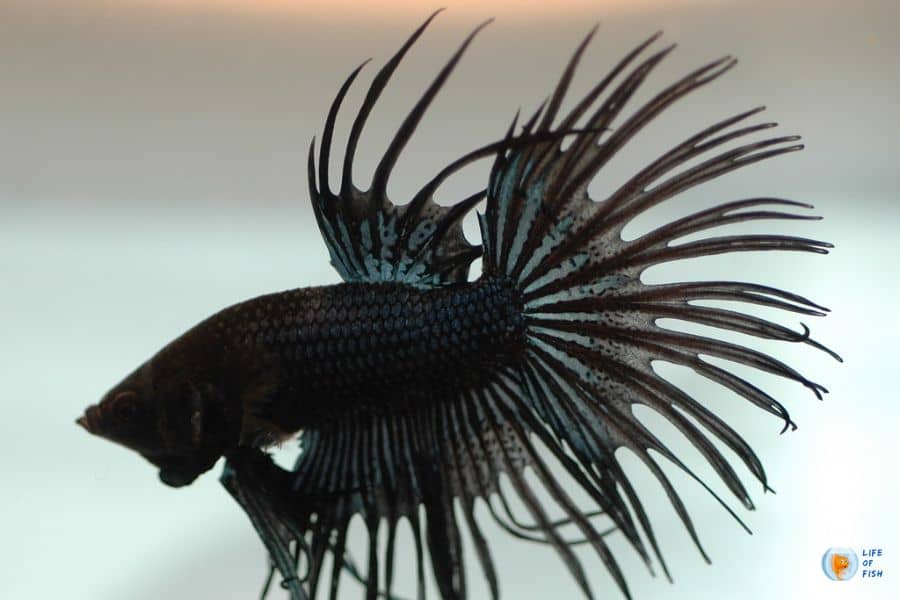
How big they can grow?
Normally they are 2.25 inches (5.7 cm) long when fully grown. A Betta can grow as large as 3 inches (7.6 cm) in length on occasion and under the right conditions. How large your Betta is ultimately depended on its age and how well it is cared for. Males have larger fins than female bettas, however, in adulthood, their bodies are about the same size (average length). Male fish fins make them look bigger and longer. Male fish also have thicker bodies than female fish.
the life expectancy of Black orchid Betta
Most of them will live for 3-5 years, but normally you are unknown how old they will be when you adopt them. Some will live longer than this age rate, while others will die at a young age no matter what you do. Unfortunately, a pet that is any species you have, some will not set up to make it until old age. If your Betta has exceeded the 1.5-2-year limit, we consider them “geriatric”.
However, you can celebrate their longevity by keeping their environment at a high level. If you are following the below tips, it allows your Betta to live a long and happy life. • Build lots of rest spots for them • Feed them well with a good quality diet • Make sure your filter flow does not push them too much. • Maintain not only good water condition by regular water changing but also a good environment
Different types of orchid bettas
- Black Melano Bettas
- Melanophore Bettas
- Black Lace Betta
- Black Orchid Betta
- Black Devil Betta
- Black Ice Betta
- Copper-Based Black Betta
- Black orchid Crowntail Betta
If you want to learn more about these variations go to this blog post “Different Types Of Black Betta : Get Hooked on Black Betta Fish“
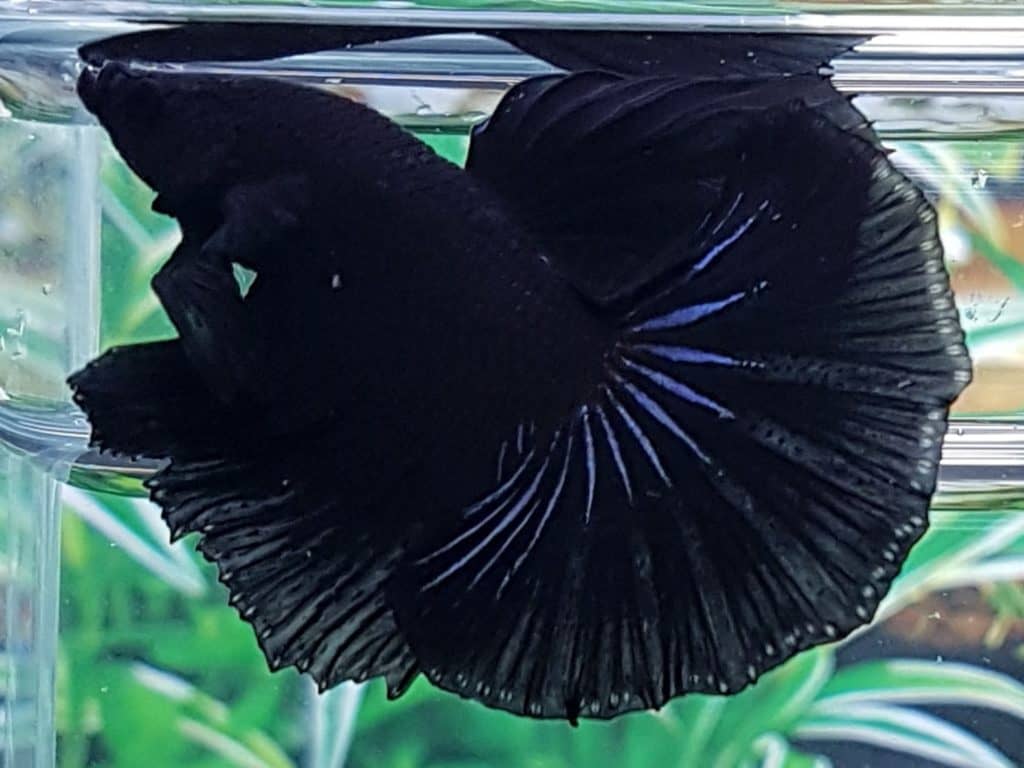
One look Care Guide
Scientific name B. splendens Common names Care Level Native to Type Color Life expectancy Tank size Preferred temperature o FpH Other water parameters ammonia, Nitrate, Nitrite Water Size Growth rate Temperament Recommended tank mates Preferred food Feeding frequency Breeding
How to care for them
As long as you provide the right water conditions , proper water exchange, and the right diet, caring for this fish is fairly simple.
Standard Tank Size
Many inexperienced people assume that the best size is a Betta vase or similar container for one of Black Orchid Betta. But in wild, Bettas need at least around three feet to live. So, ideally, tank-kept bettas should live in an aquarium of at least 5 gallons. The tank should be long, not tall.
This is because Betta is a surface feeder, and also, they need to get air regularly. Therefore, be sure to leave at least an inch of space between the surface of the water and the tank cover slides so that your Betta can get surface air when they need it.
A shallow tank is best for the Betta because the fish do not have long distances to swim to reach the top and also it reduces the harm that can occur to their large and flowing fins. A well-fitting lid is important to your tank because it can and do the jump. Especially if the Betta is pursued by an aggressive tankmate. Also, the light you choose for your Betta tank should be slightly brighter.
Do you want to know more about other fish tank sizes? you can read these articles.
- Horn Shark Tank Size (You Might Need A Bigger Tank)
- Do You Know Rope Fish Tank Size And Conditions? (Now You Know!)
- Blood Parrot Cichlid Tank Size | 13 Less Known But Important Facts |
- Amazon Leaf Fish Tank Size | 8 Important Facts |
Recommended Water Quality
Black Orchid Betta prefer water with a neutral pH level between 6.5 and 7.5, therefore be sure to check the pH level of the water in the tank every week.
Filtration
in wild, Bettas can live in stagnant water in their wild environment. But your aquarium must have an efficient filtration system. A filtration system helps to remove organic waste and remove uneaten food from the tank. Also, it helps to keep nitrate levels low and maintain a healthy environment for Black O Betta .
Black Orchid Bettas Breeding
Normally Bettas are a type of fish that can spawn readily. When your male fish build company with female fish, it causes to encourage natural breeding behavior. Also, bubble nests are built by male Black Orchid Bettas, which are usually located inside the caves and underneath some leaves near the surface of the water.
You can distinguish easily when male and female Bettas are ready to mate. After the chasing ritual, the female fish lays eggs, and the male Betta carefully collects them and places them in the bubble nest. After a few days, the tiny fry will come from the eggs.
How to feed
Wild Betta is an omnivores and they feed on vegetation, insect larvae, and insects that land on water surfaces. Black Orchid Betta can become a picky eater in captivity. Especially when they come to their new home. Encourage your beta to eat by giving him a variety of live and frozen foods such as bloodworms, mosquito larvae, and daphnia.
When providing frozen foods, keep in mind to soak the food in a little tank of water before giving it to your Betta. Always get live food from a reputable fish store, and never use anything you get from the environment. Because things that collect from the environment may contain parasites or bacteria that can damage your fish.
How much to feed a Black Orchid Betta?
Most adult fish eat dry foods in the form of pellets or flakes same as baby bettas. However, you should check if the protein content of the food is at least 40% meat-based. overfeeding your fish can cause swelling, swimming bladder problems, and constipation and the stress caused by these conditions can be fatal to your fish.
It is best to feed your Betta once or twice a day, giving him enough food to keep him busy for a minute or more. Betta’s stomach is about the size of his eye, so you can see how easy it is to overfeed your fish.
How did they feel about sleep?
Betta, like all animals, must sleep to stay alive. They sleep in different places and positions. Some are sleeping in nestles where located among the gravel of the tank and some are finding hidden places within ornaments in the aquarium. Also, some betta fish can squeeze between the filter and the tank.
Some fish float around at the top. Betta fish like to use shadow cast or holes within the aquarium ornaments to sleep. They always find a safe place to sleep. Betta fish sleep at night and they have a few rests throughout the day. Fortunately, their sleep patterns are very similar to the sleep patterns of humans.
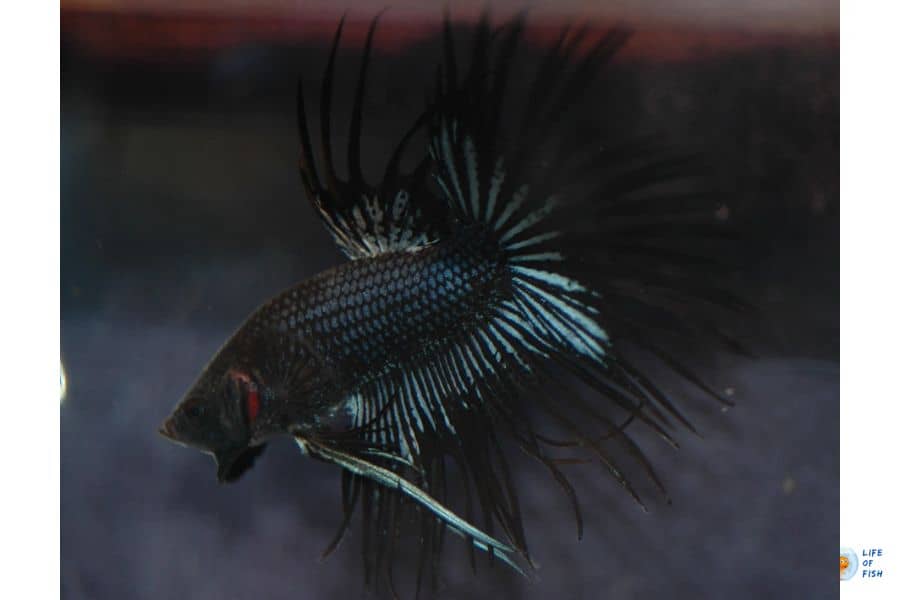
How do I keep my Black Orchid Betta healthy?
To keep your fish healthy, you need to pay attention to a few things.
• What to feed your Black Orchid Betta
Your Betta needs a healthy and consistent diet to be colorful and healthy. If you want to feed them, their diet may include frozen and dried foods. Also, they can feed on brine shrimp or blood worms. These fish are very small but active therefore, they can often eat more than they can eat. Because pay attention to avoid overfeeding. Normally, feed your Betta once or twice a day.
• When should the water in the tank be changed?
There are two ways to change the water. The first one is partial water changes and another one is total water changes. If you keep your Betta in an unfiltered small bowl, you should change the water 30-50% every week. If your betta lives in a filtered tank, you may need to change about 20% of your water per week.
• How to maintain the tank?
The cornerstone of any successful aquarium is the stable water parameters. You need to make sure they are all in the right range (always). Because unstable parameters cause to lead your Bettas to sickness. Because of that, you should measure water parameters every few weeks. Another important aspect of maintenance is changing the water.
• How to choose the best tank mates for Black Orchid Betta.
Very often Betta male animals are aggressive and they tend to fight. Because it is recommended to keep one male fish in the tank. You can keep two female fish with one male fish. Fish with large flowing tails, like guppies, should be avoided. Other fish to avoid are Oscar, parrotfish, killifish, or Acaras. Compatible fish are Poecilia, Black Tetras, Bloodfin Tetras, Catfish, Croaking Gourami, and Rasboras.
Read more Betta Fish Poop 21 Things You Should Know
Keeping Tips Summary
• Tank conditions
Ideally, the Betta in the tank should live in an aquarium of at least five gallons. The tank should be long, not tall.
• Filtration
your aquarium must have an efficient filtration system. A filtration system helps to remove organic waste and remove uneaten food from the tank. Also, that will help to maintain good water quality in the yank.
• Temperature
Bettas are highly susceptible to heat shock, so it is important that the aquarium temperature does not fall below 690 Fahrenheit and should always be between 780 and 800 Fahrenheit.
• Water quality
fighting fish prefer water with a neutral pH level between 6.5 and 7.5, therefore be sure to check the pH level of the water in the tank every week.
• Decoration and toys
Bettas in a well-planted tank are active and there are plenty of hidden places where fish can retreat if they feel threatened. Also, the Black Beta likes to rest from time to time; dragging such a luxurious slim tail all day long is a daunting task!
If you include flat-leafed plants in your tank, your Betta will happily stay on that leaf. Give your Betta fish a few toys and he will be interested and he will be active and entertaining, especially if you decide to keep your Betta alone.
• Tankmates
Very often Betta males are aggressive and they tend to fight. Because it is recommended not to keep it in a community tank. Fish with large flowing tails, like guppies, should be avoided. Other fish to avoid are Oscar, parrotfish, killifish, or Acaras. Compatible fish are Poecilia, Black Tetras, Bloodfin Tetras, Catfish, Croaking Gourami, and Rasboras.
• Feeding
Your Betta needs a healthy and consistent diet to be colorful and healthy. If you want to feed them, their diet may include frozen and dried foods. They can feed on brine shrimp or blood worms. These fish are very small but active therefore, they can often eat more than they can eat. Because pay attention to avoid overfeeding. Normally, feed your Betta once or twice a day.
How much do Betta fish cost?
Beta fish prices for the best and most valuable coloration and models vary from a few dollars to thousands. One gold Betta once sold for $ 1,000, and more recently at a multi-colored fish auction for over $ 1500.
History and origin
Black orchid Betta as a fighting fish
Some people in Thailand and Malaysia have been collecting wild Betta since at least the 19th century, observing their aggressive nature and fighting against each other in gambling games similar to cockfighting. The popularity of these battles caught the attention of King Rama III of Thailand. He had taken steps to regulate the match and levied taxes.
Also, he collected his fish for the matches. In 1840 he gave some of his precious fish to Theodore Edward Cantor, a Danish physician who had served in the Bengali medical service. Nine years later, for the first time, Cantor published the first recorded article describing these fish and named them Macropodus pugnax. In 1909, the British ichthyologist Charles Tate Regan discovered that there was a related species already namely Macropodus pugnax, hence the domesticated Siamese fighting fish was renamed Betta splendens or “Great Fighter”.
In the wild, Betta competes with other freshwater fish for only a few minutes before one fish retreats. But specially domesticated Betta bred for heightened aggression. The winners are determined as the fish who like to continue the fighting and when a fish retreats, the game is over. Fighting to the death was rare, because of this the bets were replaced on the bravery of fish rather than survival.
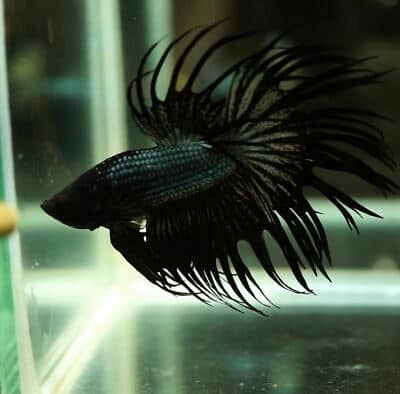
Related questions
Why is my Betta turning black?
The color of your Betta can fade due to stress, old age, injuries, and illness. If your Betta turns black, you should not worry too much if it does not show other symptoms. Strips, anchor worms, ichthyosis, stress, and fin rot will turn your Betta white.
What is the rarest color of betta fish?
The rarest color of all is the Purple Betta and the real purple Betta is almost unheard of. True purple Betta has a deep purple color, including fins.
Are Black Orchid Bettas Aggressive?
Very often male Bettas are aggressive and they tend to fight each other. Because it is recommended to keep one male fish in the tank. You can keep two female fish with one male fish.
Do they jump out of the tank?
Yes. Black orchid Betta can jump, especially if chased by an aggressive tank mate. Because your tank should have a lid that fits well.
Are there Black Betta fish?
Yes. There are several types of them such as Black Orchid, Black Ice, Black Melano, Black Lace, and the Black Devil. The intensity and depth of the black vary among variants, and some are covered in blue, green, and steel with a grayish tinge.
Is Black Orchid Betta rare?
No, they are not “rare”. You can buy high-quality Betta from breeders and aquariums.

Please realize that you just sentenced these poor fish to a 1/4 gallon tank which is like you living in a closet! Yiu will be alive but you certainly will not thrive! They need more swimming room than that and ammonia builds quickly in such small tanks. Please consider editing your remarks on what a betta splendor needs to live and THRIVE! Thanks
Dear Moloney,
Thank you for your valuable comment. I correct the post accordingly.